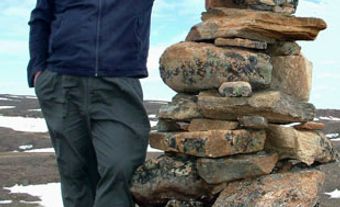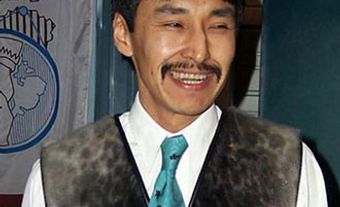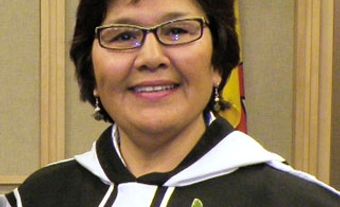
The name “Caribou Inuit” stemmed from Europeans who took part in the Fifth Danish Thule Expedition (1921–24) and observed that the Kivallirmiut relied on caribou for food, clothing and shelter. Based on recent estimates, the Kivallirmiut today number about 3,000.
Territory
The Kivallirmiut live in the Kivalliq Region of Nunavut, which consists of the portion of the mainland to the west of Hudson Bay. Before Nunavut became a territory on 1 April 1999, the Kivalliq Region was known as Keewatin Region, Northwest Territories.
Early History
The early history of the Kivallirmiut is unclear. While some anthropologists such as Birket-Smith (1929), Rasmussen (1930) and Csonka (1995) argue that the Kivallirmiut originated from an early Inuit culture present in North America and Greenland, others such as Mathiassen (1927) believe that they descend from the Thule. These initial studies by anthropologists during the 1920s saw the Kivallirmiut as a remnant of an ancient way of life that existed before most Inuit groups descended to the coasts and became marine hunters. This view was based on their unique adaptation to the interior, and on the character of their Aboriginal material culture. A third theory, upheld by Taylor (1972) and Burch (1978), suggests that the Kivallirmiut’s ancestors are a subgroup of Inuinnait (Copper Inuit) who traversed the Arctic coast in the 1600s.
Culture and Society
Historically, the traditional social organization of the Kivallirmiut was based on patriarchal family relationships and partnerships. These social units frequently moved from one regional group to another. As a means of preserving culture, singing and the telling of personal and cultural histories figured prominently in the often-held feasts and activities that took place in the society (see Inuit Myth and Legend; The Goddess of the Sea: The Story of Sedna).
There is limited information regarding the traditional material culture of the Kivallirmiut as a result of the fact that by the time they were studied by anthropologists, they had used and relied upon European technology for over a century. The use of oral history and traditional knowledge provided by Inuit groups and elders helps to clarify their unique perspectives on pre-European modes of life.
Traditional Life
Traditional seasonal activities involved primarily fishing and hunting caribou during the spring and fall migrations. During the fall hunt, populations gathered at a few good hunting spots to replenish their food supplies for winter. Caribou skins were used to make clothes and containers, as well as tents during the summer months and snowhouses during the winter. Likewise, caribou bones were used to make tools. Historically, Kivallirmiut differed from other Inuit in their dependence on inland resources, making only occasional visits to the coast to obtain sea mammal products either through hunting or by trading with coastal Inuit. Although traditional forms of hunting have largely been replaced by snowmobile and modern weaponry, hunting caribou and fishing remain an important part of the economy.
Contact with Europeans
Although contact with non-Inuit traders and explorers has been recorded as early as 1612, regular trade only began in 1718, with a trading vessel of the Hudson’s Bay Company (HBC) in what was to become Churchill, Manitoba. For the next two centuries, the HBC remained a major source of contact for the Kivallirmiut. However, there were other agents of contact including whalers, missionaries and explorers. Trading with the Europeans provided the Kivallirmiut with firearms that allowed them to hunt caribou more efficiently. In order to follow the caribou and to trade furs with the Europeans, the Kivallirmiut travelled further into the interior. This practice, in combination with European diseases and the increasing scarcity of the caribou, nearly decimated the Kivallirmiut population in the early 20th century. Some estimates suggest that from 1915 to about 1924, a severe famine killed nearly two thirds of the population. Turning to the waged economy and/or trapping (often for fox fur), the Kivallirmiut became increasingly dependent on European trade.
Arctic Relocations
As a result of the lack of available food sources, the federal government began a relocation project in the 1950s that forced the Kivallirmiut to abandon their small camps and snowhouses to live in houses built for them in the villages of Chesterfield Inlet, Arviat, Eskimo Point (now Arviat), Rankin Inlet, Baker Lake and Whale Cove. Many Inuit believe that the real reason for the relocations was to populate — and thereby claim — areas of the Arctic for Canada. Communities were separated in the process, and many Inuit died during these relocations.
Kivallirmiut Today
Today, the Kivallirmiut consist of a series of five independent inland groups: Qairnirmiut, Harvaqtuurmiut, Hauniqtuurmiut, Paallirmiut and Ahiarmiu. These bands live along the western shores of Hudson Bay in the villages of Chesterfield Inlet, Rankin Inlet, Whale Cove, Eskimo Point (now Arviat) and Baker Lake. Although various dialects of Inuktitut are spoken in the society, they all stem from the Inuit-Inupiaq language.
Environmental Activism
The Kivallirmiut have expressed concern about a uranium project located 80 km west of Baker Lake. Community members fear the possible negative socioeconomic impacts that the mine will have on the local population. Hunters have also raised concern that the mine might disturb caribou migration. Although speculation about the mine is ongoing, the Kivallirmiut and the Dene in Saskatchewan continue to oppose the uranium project.

 Share on Facebook
Share on Facebook Share on X
Share on X Share by Email
Share by Email Share on Google Classroom
Share on Google Classroom







